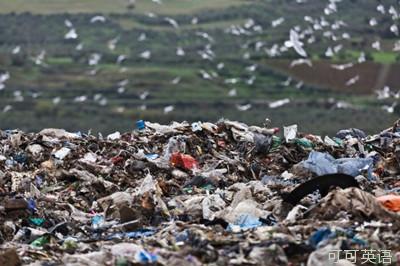Books and Arts; Book Review;Our love of garbage;Rubbish heaps;
文藝;書評;我們對垃圾的愛;成堆的垃圾;
Garbology: Our Dirty Love Affair With Trash. By Edward Humes.
《垃圾學:我們對垃圾非常感興趣》,Edward Humes 著。
Although it is the buried tombs and the lost cities that get all the press, one of the most valuable things that an archaeologist can dig up is rubbish. Palace murals and heroic statues record the sanitised, official version of history, but a society's garbage tells the true story of how its members lived.

雖然深埋的古墓和迷失的城市占據了所有的新聞版面,但是垃圾,卻是考古學家們最值得深挖的東西。宮廷壁畫,英雄雕像,那些記錄的都是一塵不染的東西,是歷史的官方版本,但是,一個社會的垃圾講述的卻是實實在在的市民生活。
With that thought in mind, archaeologists of the future are in for a treat. The industrial societies of the world's developed countries are the most wasteful ever, their spoor turning up in every corner of the Earth. Almost by definition, waste is something that most people prefer not to think too much about. But Edward Humes, an American journalist, is fascinated by the stuff. “Garbology” is his attempt to make sense of our historically unprecedented readiness to throw things away.
這樣想來,我們確實是好好地款待了那些未來的考古學家們。因為處于工業社會的發達國家,他們制造了有史以來最多的垃圾,地球上的每個角落都有他們的足跡。很顯然,大多數的人是不怎么會深思垃圾這類東西的。但是愛德華休姆斯,一位美國記者,卻對垃圾如此著迷。他試圖通過“垃圾學”,搞清楚我們為什么會及其相當之非常愿意扔東西。
The book begins at the Puente Hills landfill, an artificial mountain near Los Angeles. It is the biggest dump in America, 30 years old, 150 metres high and containing 130m tonnes of rubbish within a 700-acre footprint. If it were a building, it would be among the 20 tallest in the city. Building a rubbish pile is, it turns out, surprisingly high-tech. The mountain is a giant, putrid layer-cake, with dozens of strata of rubbish separated by soil and plastic liners designed to contain the brew of noxious chemicals that would otherwise leach into groundwater. The rot produces methane, which is collected via a network of pipes that penetrate the mountain, and burned to produce electricity.
本書以朋地山垃圾場開頭,朋地山垃圾場,靠近洛杉磯,大得看起來像一座假山。是美國最大的垃圾堆,30歲高齡,150米高,1.3億噸,700英畝。假如它是一座建筑物的話,那就能名列該城市前20名了。建一座拉一堆可不是易事,事實證明,技術含量出奇的高。這座大山猶如一個腐爛的大蛋糕,幾十層的垃圾,由土和塑料管隔開。設計塑料管的目的,是為了防止變質中的有毒化學物質浸入地下水。腐爛物產生沼氣,經由管網收集,管網貫穿大山之中,然后燃燒發電。
From there, Mr Humes traces the history of garbage in America, beginning with New York's “White Wings”, an army of municipal rubbish collectors created to clean the city's stinking streets in the 19th century, through the heyday of backyard incinerators (and the smog they produced) to the modern day, where the most common solutions often involve burying the stuff in the ground or dumping it in the sea. He talks to the researchers who are chronicling the plasticisation of the oceans, a swelling suspended solution of pulverised plastic. And he describes the Great Pacific Garbage Patch, an enormous expanse of the Pacific Ocean where currents concentrate the trash over a continent-sized area.
休姆斯先生從那里去追溯美國的垃圾歷史。先從紐約“白翼”開始,紐約“白翼”指的是19世紀,為了清掃臭氣熏天的街道,市里成立的專門用于收垃圾的群體。之后是后院焚燒爐活躍期(還有焚燒爐產生的煙霧)。再后就是如今,最普遍的垃圾處理方法莫過于地下掩埋或是傾倒大海。休姆斯先生與從事海洋塑化記錄的研究員一起,談論那懸而未決的、了不起的粉末塑料解決方案。他說,太平洋垃圾帶,使太平洋體積膨脹變大,水流將垃圾集中到一起,大小有陸地那么大。
The author is just as interested in the creation of rubbish as its disposal. But whereas few will disagree with the gist of his observations about the shortcomings of our modern, disposable, consumer culture, the analysis is rather superficial. Mr Humes comes close to blaming a single man—J. Gordon Lippincott, an industrial designer—for the creation of the entire wasteful model of modern consumerism. And although it is understandable that an American author should write a book looking mostly at the problems of America, it nevertheless feels like a missed opportunity. Some of the most interesting parts of the book come towards the end, where he discusses some of the possible solutions—such as Denmark's strategy of burning rubbish to produce electricity, or an Irish scheme to charge shoppers for plastic bags, which led to a 90% drop in their use. Food for thought, and more.
這位作者對垃圾的產生與對垃圾的處理一樣感興趣。但是他的言論宗旨,即我們現代的、一次性的消費文化缺陷,雖然很少有人反對,可是依然很膚淺。休姆斯先生幾近于只責備一個人——杰戈登利平科特,工業設計師——創造了整個奢侈的現代化消費模式。作為一個美國作者,主要寫當下美國發生的問題,是可以理解的,可是這總還是會讓人覺得缺少了點什么。一些最有趣的部分放在了最后,像關于垃圾問題的可行的解決方案——丹麥焚燒垃圾發電,或是愛爾蘭人對塑料袋收費計劃,降低了對塑料袋90%的使用。發人深思,意味深遠,超出你的想象。



